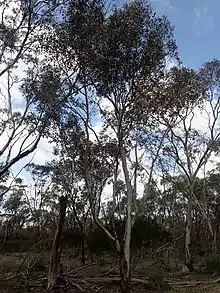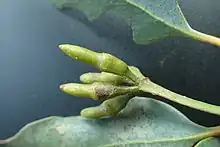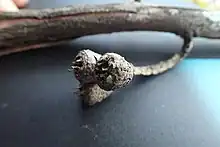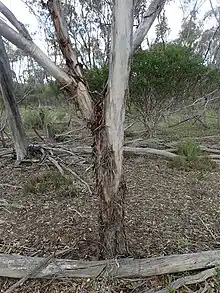| Eucalyptus calyerup | |
|---|---|
 | |
| Habit near Jerramungup | |
| Scientific classification | |
| Kingdom: | Plantae |
| Clade: | Tracheophytes |
| Clade: | Angiosperms |
| Clade: | Eudicots |
| Clade: | Rosids |
| Order: | Myrtales |
| Family: | Myrtaceae |
| Genus: | Eucalyptus |
| Species: | E. calyerup |
| Binomial name | |
| Eucalyptus calyerup | |



Eucalyptus calyerup is a tree that is endemic to a small area in the south-west of Western Australia. It has rough, fibrous bark on the lower part of the trunk, smooth bark above, elliptic to lance-shaped adult leaves, flower buds in groups of seven, creamy-yellow flowers and conical to bell-shaped fruit.
Description
Eucalyptus calyerup is a tree that typically grows to a height of 10 metres (33 ft) and rarely forms a lignotuber. It has smooth pale cream to pale pink bark above a dark grey stocking of rough bark on the lowest 70 cm (28 in) of the trunk. Young plants have leaves that are bluish green, egg-shaped, 45–60 mm (1.8–2.4 in) long and 30–40 mm (1.2–1.6 in) wide. Adult leaves are egg-shaped to elliptic, sometimes lance-shaped, the same glossy green on both sides, 38–77 mm (1.5–3.0 in) long and 15–40 mm (0.59–1.57 in) wide on a petiole 5–15 mm (0.20–0.59 in) long. The flower buds are arranged in groups of seven in leaf axils on a flattened peduncle 20–35 mm (0.79–1.38 in) long, the individual flowers on a pedicel 2–4 mm (0.079–0.157 in) long. Mature buds are 20–33 mm (0.79–1.30 in) long, 6–8 mm (0.24–0.31 in) wide with a horn-shaped operculum that is narrower than, but about twice as long as the floral cup. Flowering occurs between October and December and the flowers are creamy yellow. The fruit is a woody, conical to bell-shaped capsule 8–14 mm (0.31–0.55 in) long and 8–12 mm (0.31–0.47 in) wide on a pedicel 2–3 mm (0.079–0.118 in) long.[1][3][4]
Taxonomy and naming
Eucalyptus calyerup was first formally described in 2002 by Nathan K. McQuoid and Stephen Hopper from a specimen collected from near Calyerup Rocks, east of Jerramungup. The description was published in the journal Nuytsia.[5] The specific epithet (calyerup) refers to the type location. The ending -ensis is a Latin suffix "denoting place, locality [or] country".[4][6]
This species is possibly a stabilised hybrid between E. occidentalis and E. platypus, although the latter species does not occur in the same location.[4]
Distribution and habitat
This eucalypt is found around rocky outcrops in the Great Southern region of Western Australia between Katanning and Jerramungup where it grows in sandy-loam soils over granite.[1]
Conservation
This species is classified as "Priority One" by the Government of Western Australia Department of Parks and Wildlife,[1] meaning that it is known from only one or a few locations which are potentially at risk.[7]
Use in horticulture
Eucalyptus calyerup has been used extensively by the local Landcare group and has been shown to be resistant to lerp attack.[4]
See also
References
- 1 2 3 4 "Eucalyptus calyerup". FloraBase. Western Australian Government Department of Biodiversity, Conservation and Attractions.
- ↑ "Eucalyptus calyerup". Australian Plant Census. Retrieved 3 April 2019.
- ↑ "Eucalyptus calyerup". Euclid: Centre for Australioan National Biodiversity Research. Retrieved 3 April 2019.
- 1 2 3 4 McQuoid, Nathan K.; Hopper, Stephen D. (2002). "Eucalyptus calyerup (Myrtaceae), a new species of possible hybrid origin from south-western Australia" (PDF). Nuytsia. 15 (1): 64–66. Retrieved 18 June 2020.
- ↑ "Eucalyptus calyerup". APNI. Retrieved 3 April 2019.
- ↑ Brown, Roland Wilbur (1956). The Composition of Scientific Words. Washington, D.C.: Smithsonian Institution Press. p. 303.
- ↑ "Conservation codes for Western Australian Flora and Fauna" (PDF). Government of Western Australia Department of Parks and Wildlife. Retrieved 3 April 2019.
